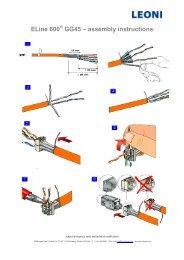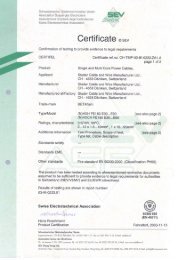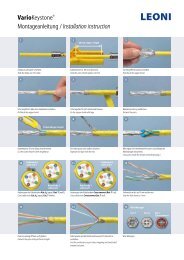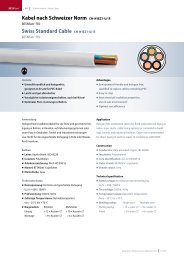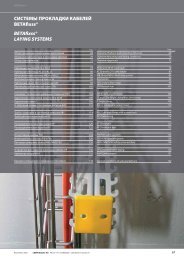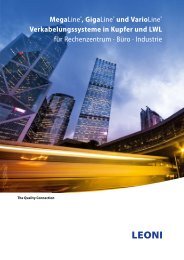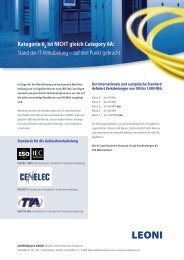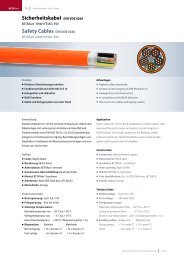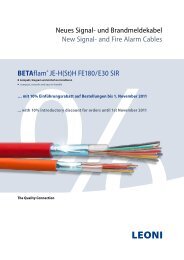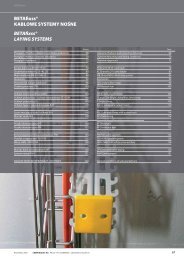Technische Information (PDF, 818 KB)
Technische Information (PDF, 818 KB)
Technische Information (PDF, 818 KB)
Erfolgreiche ePaper selbst erstellen
Machen Sie aus Ihren PDF Publikationen ein blätterbares Flipbook mit unserer einzigartigen Google optimierten e-Paper Software.
<strong>Technische</strong> <strong>Information</strong>en<br />
Technical informations<br />
HALOGENFREIHEIT UND BRANDVERHALTEN<br />
HALOGEN FREE AND FIRE PERFORMANCE<br />
HALOGENFREIHEIT<br />
Als Halogene bezeichnet man die Elemente der Gruppe 7 im<br />
Periodensystem: Chlor (Cl), Fluor (F), Brom (Br), Jod (I).<br />
Halogenfreie Kabel sind frei von all diesen Elementen.<br />
Sie werden Halogene genannt, weil sie mit Laugen zusammen<br />
Salze bilden (Hals: griechisch für Salz); Chlor bildet mit Natrium<br />
Kochsalz (NaCl).<br />
Die Halogene bilden einen Bestandteil vieler Säuren<br />
HCl = Salzsäure<br />
HF = Hydrogenfluorid<br />
HBr = Hydrogenbromid<br />
Der weitest verbreitete halogenhaltige Kunststoff ist PVC (Polyvinylchlorid).<br />
Im Brandfall wird Salzsäure abgespalten. Daher<br />
besteht die Tendenz, halogenhaltige Kunststoffe durch<br />
halogenfreie zu ersetzen. So wird beispielsweise PVC in grossem<br />
Masse durch Polyolefine ersetzt, wie zum Beispiel Polyäthylen.<br />
Dank halogenfreier Kabel verhindert man das Entstehen von<br />
korrosiven und giftigen Gasen.<br />
Prüfverfahren<br />
1000 mg Material werden auf einem vorher ausgeglühten<br />
Kupferdraht an den äusseren Rand einer Gasflamme gehalten.<br />
Anforderung<br />
Der Werkstoff gilt als halogenfrei, wenn keine grüne bis blaugrüne<br />
Verfärbung der Flamme auftritt.<br />
Chlor und Brom verfärben die Flamme, Fluor kann nicht sicher<br />
nach gewiesen werden.<br />
Prüfnorm<br />
IEC 60754-1, EN 50267-2-1<br />
HALOGEN FREE<br />
The halogens are the elements of the 7th group in the Periodic<br />
Table of Elements: chlorine (Cl), fluorine (F), bromine (Br),<br />
iodine (I).<br />
Halogen free cables must be free of chlorine, fluorine and bromine<br />
(PVC cables contain halogen, PVC = Polyvinylchloride).<br />
The halogens are an integrated component of many acids<br />
HCl = Salt acid (hydrochloric acid)<br />
HF = Hydrogenfluorid<br />
HBr = Hydrogenbromid<br />
The most popular plastic containing halogens is PVC (polyvinylchloride).<br />
In case of fire or at high temperature PVC starts to<br />
degradate. Hydrochloric acid and other fission products are<br />
generated and leads to extremely aggressive corrosion. Therefore<br />
the current trend is to replace the halogen containing plastics<br />
with halogen free ones. For instance PVC is currently being<br />
replaced at a large scale with polyolefin i.e. polyethylene.<br />
Thanks to halogen free cables the formation of corrosive and<br />
toxic gases can be prevented.<br />
Test procedures<br />
1000 mg of the testing material must be hold at one termination<br />
of an pre-annealed copper wire in a gas flame.<br />
Requirement<br />
The material is considered to be halogen free if no green to<br />
blue-green flame discolouration occurs. The chlorine and the<br />
bromine would cause such a discolouration, however the existence<br />
of fluorine cannot be proven like that.<br />
Test standards<br />
IEC 60754-1, EN 50267-2-1<br />
58 Studer Services Telefon +49 (0)6158 9208 0 info@studerservices.de März 2007



